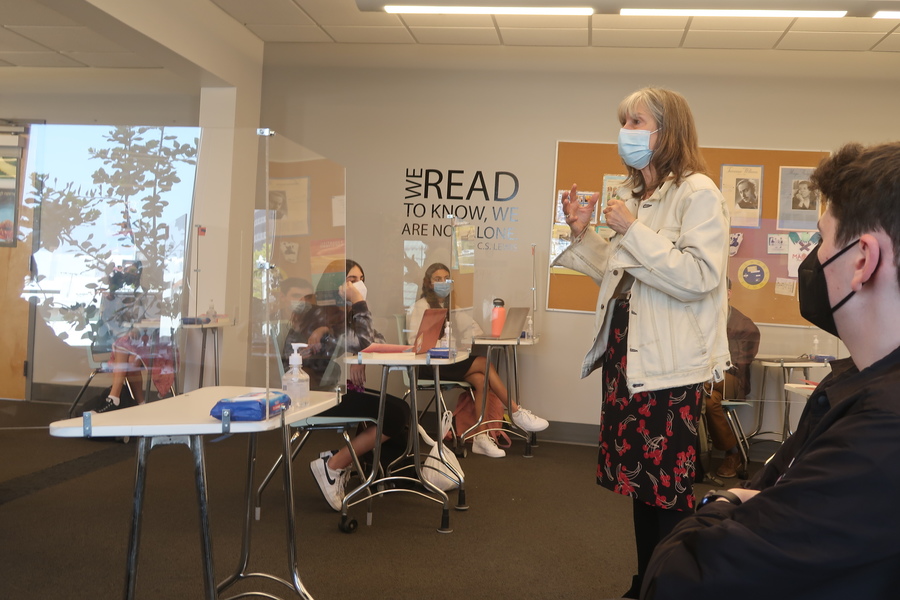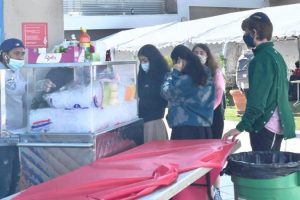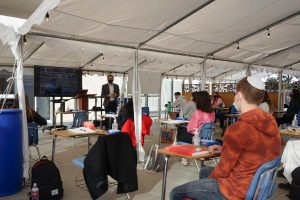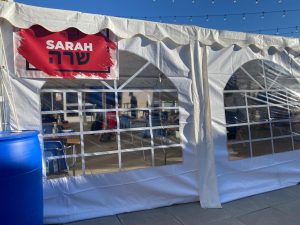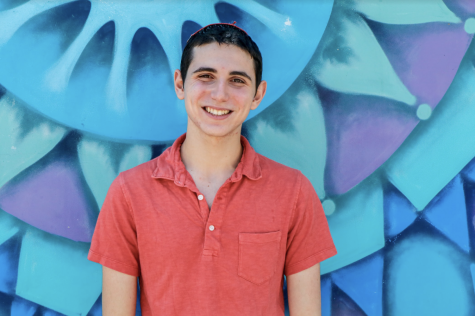All classes return in-person and in-building as LA County moves into Covid ‘Orange’ tier
LIVE: English teacher Ms. Nancy Fasules taught her 10th grade American Literature class in person April 12. Grades 10, 11, and 12 were all on campus for the first time since March 2020.
April 22, 2021
In another step closer to normal school, all classes including General Studies began meeting in person this week, three grades on campus at a time, using both indoor and outdoor classrooms,
That means only one grade per day is on Zoom, and no grade will be on Zoom more than two days per week. Friday, previously a Zoom day for all students, will become an in-person learning day for two grades at a time.
The change was first announced in a March 11 email from Head of School Rabbi David Block. Rabbi Block called it a blessing.
“What a bracha it is that the county announced … that we’ve hit the threshold needed to move towards the Red Tier – which allows schools to more fully reopen!” Rabbi Block wrote in his email.
Schedule details for April were announced April 1.
- On Mondays, 10th, 11th, and 12th graders are on campus while ninth grade is at home.
- On Tuesdays, ninth, 11th, and 12th grades are on campus while 10th graders are at home.
- On Wednesdays, ninth, 10th, and 12th grades are on campus while 11th graders are at home.
- On Thursdays, ninth, 10th, and 11th grades are on campus while 12th graders are at home.
- On Friday April 16, ninth- and 10th-graders will be on campus while 11th- and 12th-graders will learn online.
- On Friday April 23, 11th and 12th graders will be on campus, while ninth and 10th graders learn online.
- On Friday April 30, only 12th graders will be on campus.
Rabbi Block said some classes would remain outside so that the building could still manage social distancing while three grades are present. He also said there were no plans to change the bell schedule.
“Right now the plan is not to change the learning schedule — simply how many days students are on campus for,” he told the Boiling Point March 24.
After the first day back, Mathematics teacher Mr. Andrew Sinajon said he had noticed the difference.
“I have more information from the whole space that we’re in,” Mr. Sinajon said. “Being able to see an actual hand raise and answer a question in real time, it felt good. It felt familiar in a good way.”
“The outcomes of being in-person in a classroom together are — I think everyone would agree — are significantly stronger in terms of your learning and in terms of our ability to connect on a teacher student level,” he said.
“It’s as easy as people as being able to raise their hand and I can see that and ask a question to them, and being able to react to the whole room of students more easily. That’s just a little harder with a window on a computer screen.”
In anticipation of the return, for only the second time this school-year students were required to be tested for Covid-19 if they want to be on campus this week. The week following Passover was a virtual learning week so families who traveled over Passover could quarantine following their return. Testing took place in the Shalhevet parking lot on April. 9. The first time students were required to be tested was following semester break on Jan. 28.
The latest changes were made possible because the county’s Covid test positivity rate and cases per 100,000 have decreased. As of April 14, L.A. County had a case positivity rate of 1.2%, and a daily average of 5.4 cases per 100,000. This places it in the Orange Tier.
California uses a tier system to describe the level of Covid severity in different counties, and based on that determines which sectors of the economy can reopen.
Grades seven through 12 were eligible to reopen on March 15, when the county entered the Red Tier. Los Angeles County then moved into the Orange tier on April 5 which allows increased capacity in business sectors such as movie theatres and restaurants.
LA County entered the Orange tier on April 5, reflecting a case positivity rate between two percent and four point nine percent and between two and 5.9 cases per 100,000.
To enter the Yellow tier, the lowest tier in California’s tier system, LA County will have to maintain a case positivity rate of less than two percent and daily new cases below two per every 100,000 people.
The last major reopening of school occurred on Feb. 8, when Shalhevet began welcoming two grades on campus at a time for two days each week for in-person learning. But even before Pesach break, Shalhevet began planning for the post-break in-person learning changes.
“According to the initial guidance, we would’ve had to wait at least two weeks after hitting the threshold to move to the Red Tier; practically speaking, that would’ve taken us to after Pesach,” Rabbi Block wrote in an email on March 11. “But we’re actually hopeful that we’ll be able to do a lot of that even sooner.”
“Naturally,” he wrote, “we’ll want to benefit from that as soon as we can. So, instead of simply continuing our post-Pesach plan, if we do enter the Red Tier, we’re going to use next week as a ‘soft-start.’”
So two weeks before Pesach, although there were only two grades on campus, teachers were allowed to use indoor classrooms and many General Studies classes met in person.
The week before pre-Pesach quarantine, starting March. 15, both Judaic and some General Studies classes met indoors. Among those were 10th grade Visual Art, Mr. Forrester’s 10th-grade American Literature class, 11th-grade Interrogating Evil in British Literature, Advanced Economics, ninth-grade Journalism, SAS Music theory, Jewish Literature, SAS Biology, ninth-grade World History, and Dr. Harris’s 10th-grade Honors U.S. History class, as well as all Judaic Studies classes whose teachers felt comfortable coming to campus.

